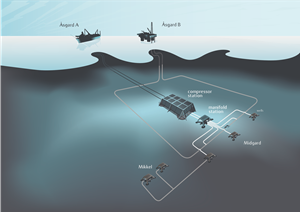World’s first subsea gas compression plant on line, Statoil says
STAVANGER, Norway -- Statoil and its partners have, this week, put the first subsea gas compression facility on line at Åsgard field in the Norwegian Sea. Subsea compression will add some 306 MMboe to total output over the field’s life.
This subsea technology milestone opens new opportunities in deeper waters, and in areas far from shore.
“This is one of the most demanding technology projects aimed at improving oil recovery. We are very proud today that we, together with our partners and suppliers, have realized this project that we started ten years ago,” Margareth Øvrum, Statoil’s executive V.P. for Technology, Drilling and Projects, said.
Recovery from the Midgard reservoir on Åsgard field will increase from 67% to 87%, and from 59% to 84% from the Mikkel reservoir.
“Thanks to the new compressor solution, we will achieve increased recovery rates both at Midgard and Mikkel, extending the reservoirs’ productive lives until 2032,” Siri Espedal Kindem, senior V.P. for Åsgard operations, said.
Demanding technology
As a field gets older, the natural pressure in the reservoir drops. In order to recover more oil and gas, and get this to the platform, compression is required. The closer to the well compression takes place, the more oil and gas can be recovered.
Traditionally, compression plants are installed on platforms or onshore, but this plant is located in 300 m of water.
Due to the challenging location, quality in all parts of the project has been essential, and will help ensure high regularity, maximum recovery and robust production. The project started in 2005, and the plan for development and operation (PDO) was approved in 2012.
An estimated eleven million man-hours have been spent from the start until completion. More than 40 new technologies have been developed and employed after prior testing and verification. Some of this work has taken place at Statoil’s Kårstø laboratory in Western Norway. Overall, project costs were just above NOK 19 billion.
Establishing the necessary support functions onshore has been an important and substantial part of the project. A spare compression train will be stored in custom designed halls at the onshore supply base Vestbase in Kristiansund.
“High-quality, regular maintenance of the subsea modules will also be performed here, helping ensure operational excellence for Åsgard,” Kindem said.
Technology for the future
The Midgard and Mikkel gas reservoirs have been developed using subsea installations. The two gas compressors now installed on the seabed are located close to the wellheads.
Moving the gas compression from the platform to the wellhead substantially increases the recovery rate and life of the fields. Prior to gas compression, gas and liquids are separated out, and after pressure boosting recombined and sent through a pipeline some 40 km to Åsgard B.
In addition to improving recovery, subsea gas compression will be more energy efficient than the traditional topside solution. The technology significantly reduces energy consumption and CO2 emissions over the field’s life.
Today, almost 50% of Statoil’s production is recovered through some 500 subsea wells. Statoil’s subsea expertise is essential to successful production efficiency improvement and increased oil recovery efforts.
“Subsea gas compression is the technology for the future, taking us a big step closer to our ambition of realizing a subsea processing plant, referred to as the subsea factory,” Øvrum said.
Such a plant will facilitate remotely controlled hydrocarbon transportation. Current topside operations will thus be moved to the seabed, allowing oil and gas to be recovered that would not otherwise be profitable. This is an important element of increased recovery on the Norwegian Continental Shelf.



